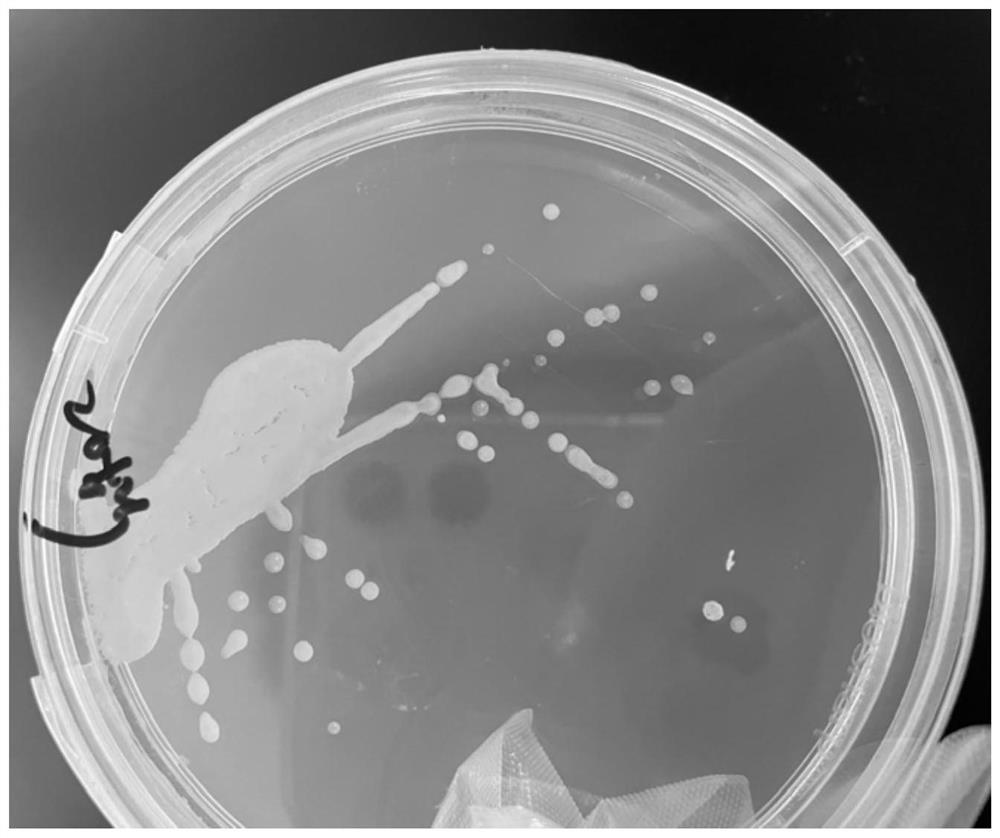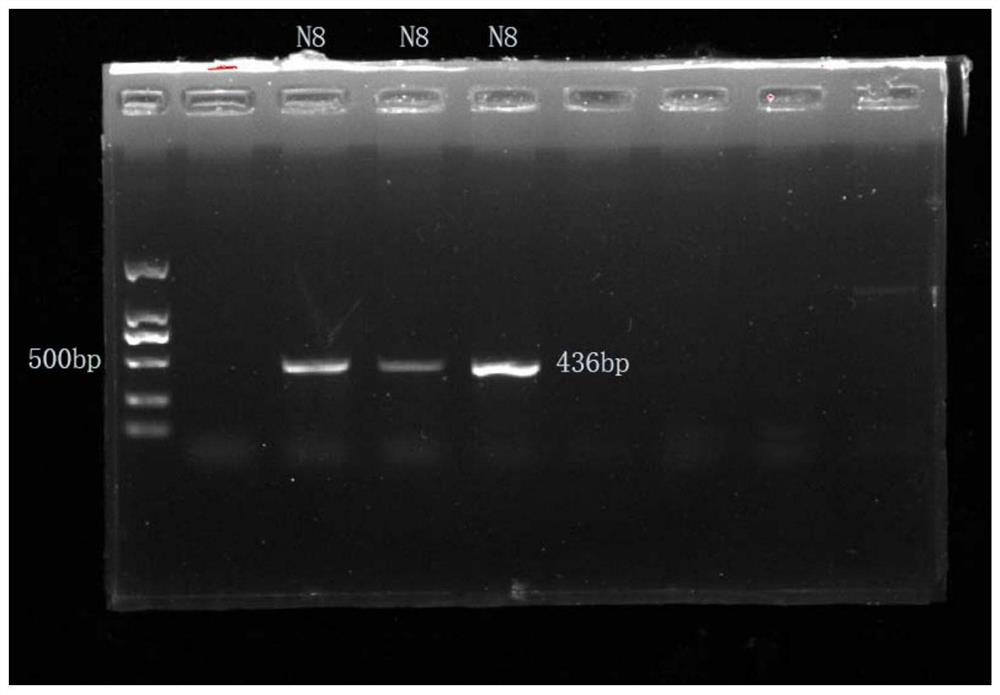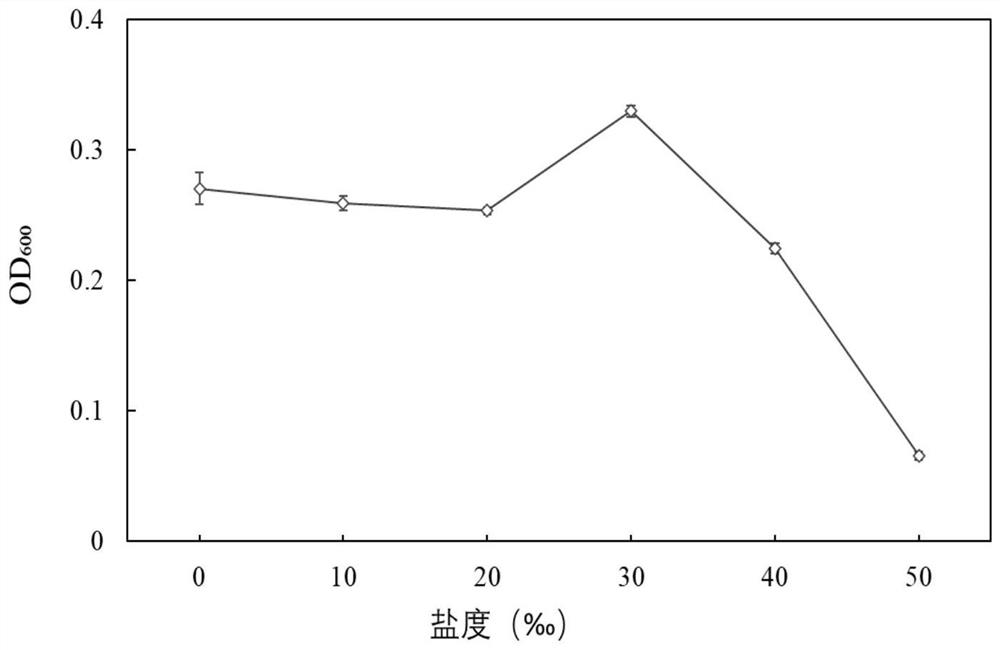Salt-tolerant bacillus amyloliquefaciens with high self-aggregation capability and application thereof in denitrification
A technology of amyloliquefaciens and bacillus, applied in the field of environmental microorganisms, can solve the problems of low denitrification efficiency and achieve high denitrification performance, high self-aggregation ability, and high removal rate
- Summary
- Abstract
- Description
- Claims
- Application Information
AI Technical Summary
Problems solved by technology
Method used
Image
Examples
Embodiment 1
[0029] The screening of bacterial strain N8 is carried out according to the following steps:
[0030] (1) Take high-density grouper culture water in a 50ml sterile centrifuge tube and store at 4°C for later use. Take 1mL water sample and put it into a 250mL Erlenmeyer flask, add 100mL nitrification enrichment medium; shake well, 30℃, 180r min -1 After 2 days, take 1 mL and re-inoculate it into fresh nitrification-enrichment medium, and then enrich and culture continuously for 5 times.
[0031] (2) Under aseptic conditions, use a pipette to draw 1 mL of the above-mentioned last-generation liquid-enriched culture solution, add it to a 20 mL test tube filled with 9 mL of sterile water, rinse with a pipette for 3 times, and mix well , which makes 10 -1 Concentration of bacterial liquid, repeat the above operations, and finally made 10 -3 、10 -4 、10 -5 、10 -6 and 10 -7 Bacterial solutions with different dilutions. Use a pipette gun to draw 0.1mL of bacterial solutions with ...
Embodiment 2
[0040] Characteristic and Identification of Strain N8
[0041] The colony of strain N8 is smaller, moister, smoother, more transparent, easy to pick, with neat edges, smooth and shiny surface. Under the microscope, the bacteria are rod-shaped and are Gram-negative bacteria. Its relevant physiological and biochemical characteristics are shown in Table 1, V-P test, gelatin liquefaction, starch hydrolysis test are positive; nitrate reduction test is negative, citrate, propionate, L-arabinose, D-mannitol can be used as Carbon source, D-xylose cannot be utilized. It cannot grow in 7% NaCl, but can grow under pH 5.7 and anaerobic conditions.
[0042] Table 1 Physiological and biochemical characteristics of strain N8
[0043]
[0044] +: growing or positive; -: not growing or negative
[0045] 16S rDNA gene sequencing and multiplex PCR identification:
[0046] PCR amplification of strain N8 genomic DNA: the total DNA of strain N8 was used as a template, and the amplification ...
Embodiment 3
[0056] Salt Tolerance Test of Bacillus amyloliquefaciens N8
[0057] Use an inoculation loop to scrape 2 loops of bacterial lawn from Bacillus amyloliquefaciens N8 stored on the inclined tube medium, inoculate it into a 250mL Erlenmeyer flask containing 100mL of sterilized LB medium, at 30°C, 140r min -1 Cultivated under the condition, until the medium OD 600 When it is 1, it is used as seed solution.
[0058] Prepare nitrification basal medium with different salinity gradients, in which NaCl concentrations are 0, 10‰, 20‰, 30‰, 40‰ and 50‰ (W / V); inoculate Bacillus amyloliquefaciens N8 seed solution with 1% (v / v) Transfer to a 500mL Erlenmeyer flask containing 300mL nitrification basal medium; shake well, 30°C, 140r min -1 Cultivate for 48 hours under the same conditions, and the strain growth status (OD 600 ) as the basis of whether the strain is resistant to the corresponding salinity; the culture medium not inoculated with bacteria is used as the blank control, and eac...
PUM
 Login to View More
Login to View More Abstract
Description
Claims
Application Information
 Login to View More
Login to View More - R&D
- Intellectual Property
- Life Sciences
- Materials
- Tech Scout
- Unparalleled Data Quality
- Higher Quality Content
- 60% Fewer Hallucinations
Browse by: Latest US Patents, China's latest patents, Technical Efficacy Thesaurus, Application Domain, Technology Topic, Popular Technical Reports.
© 2025 PatSnap. All rights reserved.Legal|Privacy policy|Modern Slavery Act Transparency Statement|Sitemap|About US| Contact US: help@patsnap.com



